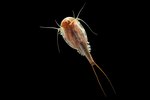Guppies, or Poecilia reticulata, are one of the most well-known species of freshwater aquarium fish. Males of the species are known for their brightly colored tails, while females of the species appear dull in coloration. Keeping guppies in the home aquarium can be very enjoyable, because these active, colorful fishes are a joy to watch and very easy to keep. Though guppies are likely to survive in a variety of water parameters, there are certain conditions in which they are most likely to thrive.
What Is pH?
The numeric device we call pH is simply a measurement of how acidic or alkaline water is on a scale from 0 to 14. Water having a pH of around 7.0 is said to be neutral. A measurement above 7.0 means the water is alkaline; a measurements below 7.0 means the water is acidic. Pure water is typically neutral in pH, though the pH of the tap water you use in your guppy tank may vary according to any treatments or dissolved chemicals in the water.
Recommended pH for Guppy Tanks
Guppies are native to northern South America, but they also are found in several of the Caribbean islands. In their natural habitat, guppies live in a wide range of biotypes and thus are very adaptable to a variety of water conditions. Though they may survive higher or lower levels, the recommended pH range for a guppy tank is between 6.8 and 7.6. More important than the pH reading itself, however, is the stability of the pH level. Changes in pH can cause fish to become stressed, which could result in a greater susceptibility to illness.
Monitoring pH
Monitoring pH levels can be very easy thanks to the availability of easy-to-use pH test kits. You can find these kits at your local pet store or order them online. Most pH test kits operate in one of two ways -- they either involve dipping a test strip into a cup of aquarium water or collecting a sample and adding a few drops of test solution. Once the sample has been taken, you need only compare the color of the sample to the chart included with the kit to find the approximate pH of your tank water. Test the pH in your guppy tank on a weekly basis to ensure that it remains stable.
Modifying pH
Because guppies are so resilient to changes in water chemistry you should not have to worry about modifying the pH in your tank. If for some reason the pH in your tank spikes to an extremely high level or drops too low, however, it may be wise to correct it. Adding baking soda at a rate of 1 tsp. per 10 gallons is the simplest way to increase pH. Lowering pH can be tricky and may require the use of a carbon dioxide injector. When you're modifying the pH in your guppy tank, test the pH frequently in order to monitor the change.
References
Photo Credits
-
fish image by Henryk Olszewski from Fotolia.com
Writer Bio
Katherine Barrington has written on a variety of topics, from arts and crafts to pets, health and do-it-yourself projects. She has a Bachelor of Arts in English with a creative writing concentration from Marietta College.




